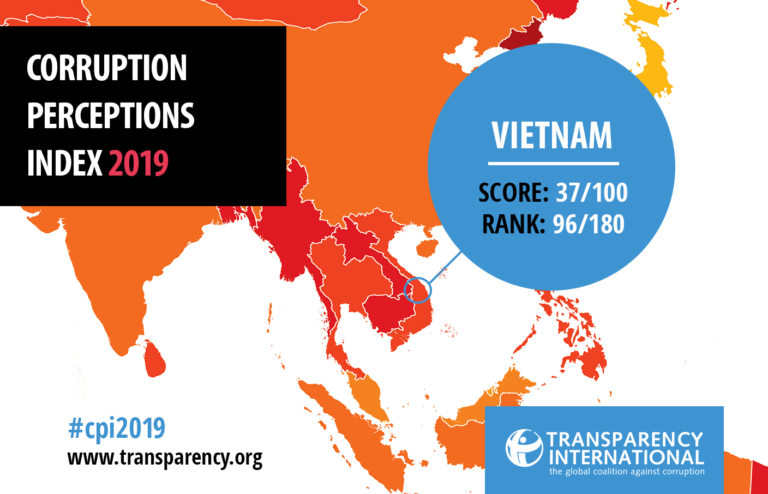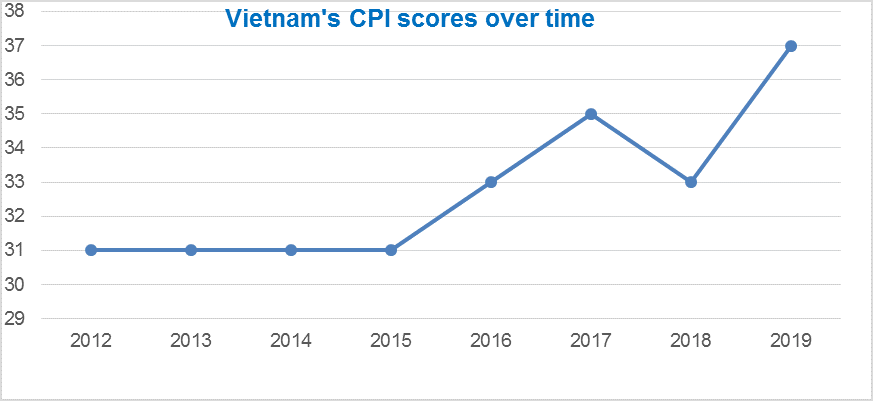Vietnam: CPI 2019 score is up but corruption remains serious

Transparency International (TI) launched the Corruption Perceptions Index (CPI) 2019 on 23 January 2020, ranking 180 countries and territories based on business people and country experts’ perception of corruption in the public sector in those countries/territories.
This year, Vietnam scored 37/100, up by 4 points compared to 2018, ranking 96/180 on the global index. Within ASEAN, Vietnam and Malaysia are the only two countries that see a statistically significant improvement in CPI score.
Towards Transparency (TT), TI’s National Contact in Vietnam recognizes that the 4-point increase in CPI score signals a positive development in Vietnam’s fight against corruption in the past year. However, on the scale of 0 (highly corrupt) to 100 (very clean), Vietnam is still among two thirds of the world’s countries scoring below 50. This means that corruption in the public sector remains a serious problem in Vietnam.

Source: Transparency International (2019)
The improvement in Vietnam’s CPI score is coherent with the findings of the Vietnam Corruption Barometer 2019 (VCB-2019) released on 7 January 2020 by Towards Transparency, which shows that while government actions against corruption are perceived as more effective, Vietnamese citizens are increasingly concerned about corruption.
According to Towards Transparency, the 2019 progress reflects the Vietnamese Communist Party and State’s efforts in improving and enforcing anti-corruption policy and legislation, especially enhancing the investigation, prosecution and trial of a number of grand corruption cases.
To keep up with this positive trend in the fight against corruption, TT recommends that the Communist Party and State of Vietnam concentrate on the following actions:
First, ensure the effective enforcement of anti-corruption legislation, especially the Anti-Corruption Law, the Law on Access to Information and the Penal Code, focusing on the implementation of regulations to enhance openness and transparency of information, accountability and integrity of public officials; and strict punishment of corruption crimes.
Second, create favourable conditions for non-state actors and citizens to engage in fighting corruption, especially through specific incentives and measures to encourage and facilitate social criticism and oversight role of the media and civil society organizations, protect whistle-blowers of corruption.
Third, issue regulations to control the relationships between public and private actors, preventing undue influence of big companies and interest groups on decisions and policies of public authorities.
Further reading on CPI
FAQs on CPI
Full key messages from Towards Transparency (TT) to the Government and society of Vietnam
Transparency International’s Press release on CPI
Info-graphic on CPI
2019
2018
2017
2016
CPI Global map – Country results of 176 countries
CPI Country results of Asia Pacific countries
Full sources description
Technical Methodology Note
2019
Short Technical Methodology Note 2019
Full Technical Methodology Note 2018
2018
Short Technical Methodology Note 2018
Full Technical Methodology Note 2018
2017
Short Technical Methodology Note 2017
Full Technical Methodology Note 2017
2016